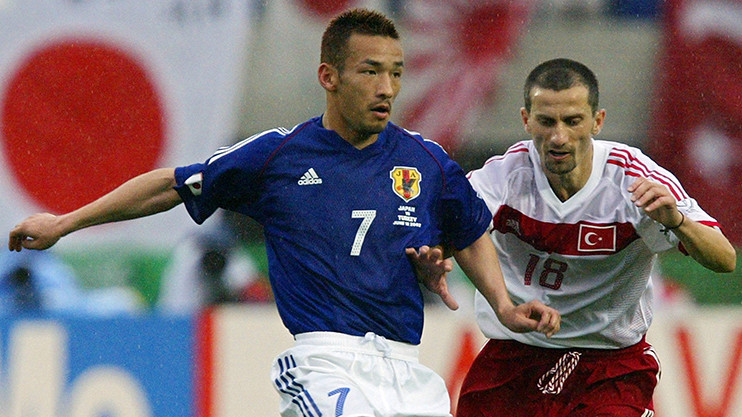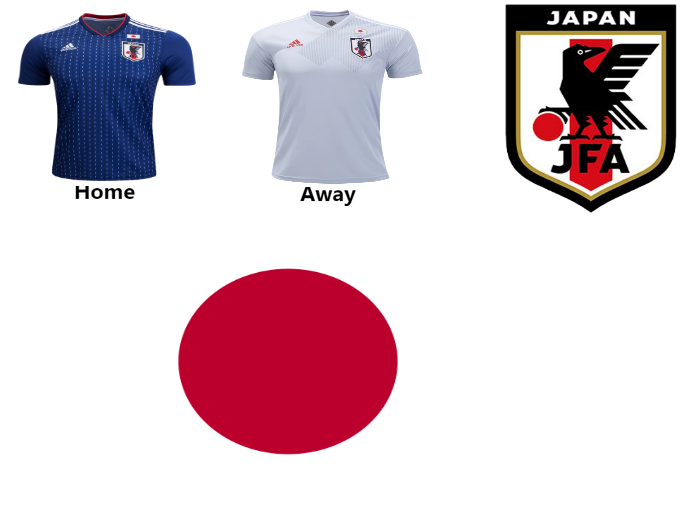 Qualification: 1st in AFC Group B. While Japan qualified quite comfortably in the end, they didn’t look totally convincing at times they were bailed out by the fact the Australia were even worse. Losses opened and closed their final qualifying group but they did go on an 8 game unbeaten run in between.
Qualification: 1st in AFC Group B. While Japan qualified quite comfortably in the end, they didn’t look totally convincing at times they were bailed out by the fact the Australia were even worse. Losses opened and closed their final qualifying group but they did go on an 8 game unbeaten run in between.
World Cup Appearance: 6th (First, 1998; Most Recent, 2014)
Best Result at a World Cup: Round of 16 (2002, 2010)
World Ranking: 60.
Coach: Akira Nishino. A lot of managers at this World Cup have come into their roles at short notice, but no-one has had as little time as Akira Nishino who was only appointed in April of this year. Vahid Halilhodzic had lead the Samurai Blue to the World Cup but poor friendly results and a shaky relationship with key players (such as Keisuke Honda, Shinji Okazaki and Shinji Kagawa) led him to be fired, with Nishino, most successful in his time in charge of Gamba Osaka, coming in. Halilhodzic’s unceremonious ousting has led the fiery Bosnian to sue the Japanese Football Association for unfair dismissal, though he is only seeking clarification about his firing, as well as a personal apology from JFA president Kozo Tashima and a single yen as a token gesture.
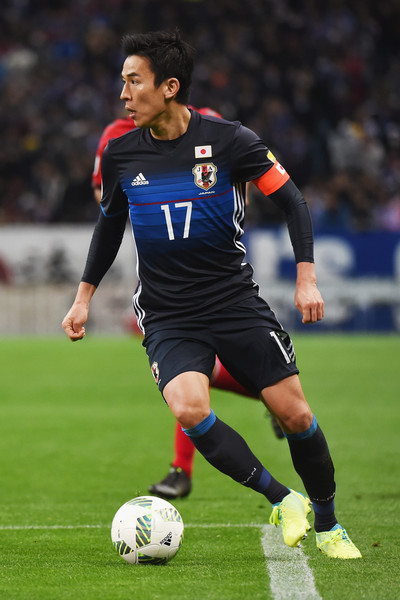
Captain: Makoto Hasebe. An absolute rock in the centre of the park for Japan, Hasebe is one of the best leaders in world football. He’s the glue that keeps Japan’s side together and with the turbulent goings on off field, hes more important than ever. On the field, he’s a hardworking midfielder who wins a lot of the ball and rarely loses it in possession. When he departs from the national team he’ll be very difficult to replace.
Key Player: Shinji Kagawa. Despite his impressive pedigree, Kagawa has been in and out of the national team recently, partially due to the fact that Halilhodzic didn’t see him as a good fit for the team tactically. Questions remain as to whether he and Keisuke Honda can coexist in the same side, with Japan potentially having to sacrifice one of their star playmakers from their starting XI for the greater good. Kagawa is an elite player with the ball at his feet and an excellent passer and his scoring record for club and country isn’t bad either.
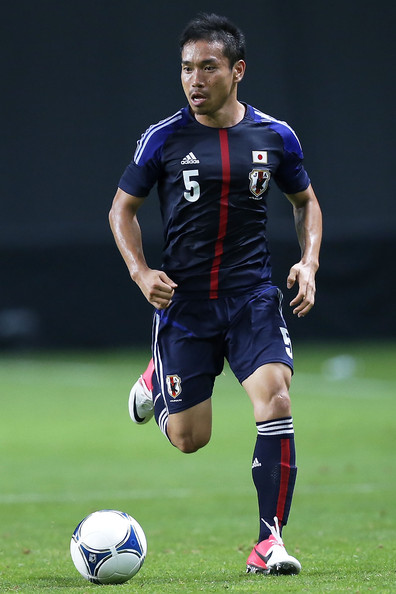
One to Watch: Yuya Osako. Shinji Okazaki is certainly the most well known striker in the Japanese squad, and could keep his place in the starting XI, but don’t be surprised if lesser known Yuya Osako overshadows the Leicester veteran in Russia. He may not be as natural a goalscorer as Okazaki but he is good at bringing other players into the game, and has been given the starting role in recent friendlies.
Miroslav Klose Award: Yuto Nagatomo. The tireless left back was well liked at Inter Milan, though many fans didn’t think he lived up to Inter’s high standards, they appreciated his hard work and passion as well as his constant improvement as a player. He’s also become a fan favourite at Galatasaray, notably performing a rather elaborate celebration when they won the league this year.
Under Halilhodzic, Japan usually played a 4-2-3-1 with a slick passing game, and it looks like that will continue under Nishino. A 3-4-2-1 has been experimented with and could also come into play, though it hasn’t produced incredible results.
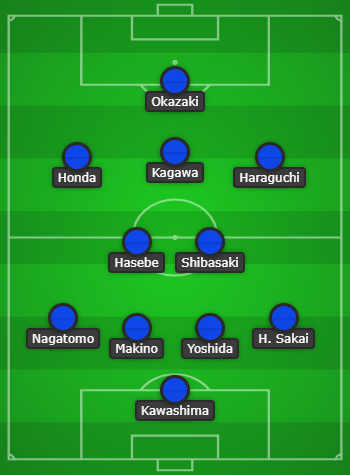 Eiji Kawashima will start in goals, playing in his third World Cup. Youngster Kosuke Nakamura and Masaaki Higashiguchi will deputise. Maya Yoshida is nailed on for a starting role at centre back though who plays alongside him will vary. Tomoaki Makino is the most likely candidate though the highly rated youngster Naomichi Ueda or Gen Shoji could get a surprise start. Of course in a back three, there is space for both of them, but its possible that Wataru Endo or Makoto Hasebe will shift from defensive midfield to fill one of the back 3 spots. At full back they have a raft of players who are capable of playing on either flank or slightly more advanced in a wing back role with Yuto Nagatomo, Gotoku Sakai and Hiroki Sakai (no relation to each other). I think the starting lineup will have Nagatomo on the left and Hiroki Sakai on the right, with the US born Gotoku Sakai unlucky to miss out. In the centre of the park, Makoto Hasebe will keep chugging along, with either Gaku Shibasaki, Hotaru Yamaguchi or Ryota Oshima alongside him. I think they should go with Shibasaki, as he’s a better passer than Yamaguchi (I don’t know much about Oshima). The question as to who will play as their central playmaker is an interesting one, with both Keisuke Honda and Shinji Kagawa excellent candidates. I think they’ll end up with Kagawa there and shift Honda onto the wing, though the opposite is entirely possible as well. Of course, Japan do have other options out wide, with the Fortuna Dusseldorf duo of Takashi Usami and Genki Haraguchi possibly preferred to one of Japans megastars. Takashi Inui rounds out a very talented corps of attacking midfielders. A 3-4-2-1 formation means that Kagawa and Honda are a more snug fit into the starting XI, but its unlikely they will play that formation unless their 4-2-3-1 proves fruitless. With Japan likely to play a lone striker, Shinji Okazaki seems the obvious choice, but Yuya Osako has started recent friendlies and could get the nod ahead of the man with 50 international goals. Yoshinori Muto is also an option up front for Nishino.
Eiji Kawashima will start in goals, playing in his third World Cup. Youngster Kosuke Nakamura and Masaaki Higashiguchi will deputise. Maya Yoshida is nailed on for a starting role at centre back though who plays alongside him will vary. Tomoaki Makino is the most likely candidate though the highly rated youngster Naomichi Ueda or Gen Shoji could get a surprise start. Of course in a back three, there is space for both of them, but its possible that Wataru Endo or Makoto Hasebe will shift from defensive midfield to fill one of the back 3 spots. At full back they have a raft of players who are capable of playing on either flank or slightly more advanced in a wing back role with Yuto Nagatomo, Gotoku Sakai and Hiroki Sakai (no relation to each other). I think the starting lineup will have Nagatomo on the left and Hiroki Sakai on the right, with the US born Gotoku Sakai unlucky to miss out. In the centre of the park, Makoto Hasebe will keep chugging along, with either Gaku Shibasaki, Hotaru Yamaguchi or Ryota Oshima alongside him. I think they should go with Shibasaki, as he’s a better passer than Yamaguchi (I don’t know much about Oshima). The question as to who will play as their central playmaker is an interesting one, with both Keisuke Honda and Shinji Kagawa excellent candidates. I think they’ll end up with Kagawa there and shift Honda onto the wing, though the opposite is entirely possible as well. Of course, Japan do have other options out wide, with the Fortuna Dusseldorf duo of Takashi Usami and Genki Haraguchi possibly preferred to one of Japans megastars. Takashi Inui rounds out a very talented corps of attacking midfielders. A 3-4-2-1 formation means that Kagawa and Honda are a more snug fit into the starting XI, but its unlikely they will play that formation unless their 4-2-3-1 proves fruitless. With Japan likely to play a lone striker, Shinji Okazaki seems the obvious choice, but Yuya Osako has started recent friendlies and could get the nod ahead of the man with 50 international goals. Yoshinori Muto is also an option up front for Nishino.
As an aside, the longevity of certain Japanese players is incredible, Yasuhito Endo, Shinji Ono and Shunsuke Nakamura (not Shinsuke Nakamura) are all still playing in the top flight of the J-League, while 51 year old ‘King’ Kazu Miura is still turning out for second division side Yokohama FC after playing his first professional game for Santos (in Brazil) in 1986.
Prediction: The instability surrounding the side will destabilise them going into a tough group. A group stage exit awaits.
World Cup Moment: Japan hosted the 2002 World Cup with South Korea, and although they didn’t reach the heights of their co-hosts, it was still Japan’s best result at a World Cup. In Group H, Japan started their campaign against Belgium, drawing 2-2 with all 4 goals coming in an 18 minute period, Marc Wilmots scoring for the Belgians in 57 minutes, before goals by Takayuki Suzuki and Junichi Inamoto saw the hosts up 2-1, with Belgium equalising in the 75th minute. In their next game against Russia, a 51st minute goal by Inamoto was enough to secure Japan’s first ever World Cup victory. Japan were guaranteed qualification into the second round but they went one step better, winning 2-0 against Tunisia with goals from Hiroaki Morishima and the iconic Hidetoshi Nakata, finishing top of their group ahead of Belgium. They faced Turkey in the Round of 16, but lost to a talented Turkish side who eventually would finish third in the tournament.
